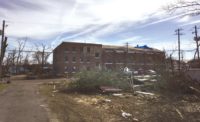Restoring a Tornado-Ravaged Gym in Small-Town Ohio

Seven tornadoes touched down across the Tri-State area of Indiana, Kentucky and Ohio on March 2, 2012, the largest of which were in Holton, IN, Crittenden and Piner, KY, and Moscow, OH. All of the tornadoes measured at EF3 on the Enhanced Fujita Scale.
Rob Hanavan and his crew at Rainbow International of Cincinnati were called in by area insurance agents in an attempt to board up windows and save what they could as the storms moved toward Moscow, a small southwestern Ohio village with a population of 310. However, road closures prevented Hanavan’s four dispatched crews from entering town and they were forced to retreat.
What ensued was a tornado that measured a quarter-mile wide. Winds reached an astonishing 160 mph as it ripped across 20 miles of land. In its path was Moscow, where homes were blown to bits and trees were broken in half. Only two out of 10 historic homes survived the storm, and the tornado is blamed for destroying more than 70% of the town.

“The damage was unlike anything I’d ever seen,” said Jeff Markovic of Pillar Insurance in Cincinnati. “The biggest problem is where to start when you have a whole village that has been destroyed. You’re never really prepared for that kind of thing. The size and scope of the damage was devastating. Some places were completely wiped off the map.”
After the storm, Hanavan was called back to check on the damage, specifically the damage to the Moscow Community Center. The center was opened in October 2004 and was made possible by a community development grant. The main feature of the building is the gym, a place where local residents gather for exercise classes and activities like basketball. The building’s roof had been picked up and thrown 100 feet, but amazingly, the building itself still stood.
“The gym floor was very wet,” said Hanavan. “It had standing water on it when we showed up. It was reading in the high 20s on the moisture equivalency scale underneath the finish, which normally means the floor cannot be saved.

“Gym floors are unusual. They are very hard to dry, and this one was much wetter than any I had previously worked on. The concrete on the ceiling was soaking wet.”
On a previous gym floor restoration job, the crew tented the entire gym floor with desiccant air from a portable unit and then pulled six inches of wood flooring from both sides of the gym, while running four LGR dehumidifiers underneath.
“We were successful on that gym floor restoration, but we had a hard time keeping heat up under the tents,” Hanavan says.
So to save the Moscow Community Center’s gym floor, they took similar action, but with a modification to better keep heat under the tents. To do this, they decided to put a double tent over the floor, which provided an insulating gap that minimized the cubic footage of area to be dried. They also removed a board from the floor to relieve pressure and keep the floor from buckling. (Making sure that the floor didn’t buckle was crucial, considering that a total replacement of the floor was likely.)
After achieving good results, the crew was able to save the gym floor, which was valued at $70,000.

In total, it cost $23,000 to save the building and floor plus $6,000 to refinish the gym wood floor. It was originally thought that an additional $150,000 in repairs was needed, but with the Rainbow International crew’s restoration plan, the additional costly repairs were unnecessary. The building and floor renovation took a week and a half. It took another three weeks for the floor to be finished.
Technical support from the Rainbow International home office was also important to the success of the job.
“In the end, we’re glad to do what we do,” Hanavan concluded. “I believe my team has the best training, technology, equipment, support and staff around. But it’s all for nothing if we lose sight of the very real and very human element of what we do as restoration service professionals. We restore so our customers can recover from terrible events like these. That’s our job and we’re proud to do it.”
Looking for a reprint of this article?
From high-res PDFs to custom plaques, order your copy today!





